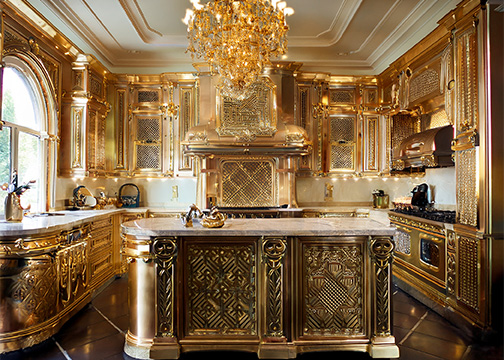
Reinvention, Identity, and the House as Self
“Renovating is no longer about fixing what’s broken; it is in the pursuit of happiness.”
There has been a surge in gut renovation projects that has been unwavering since the pandemic. Renovating is no longer about fixing what’s broken; it is in the pursuit of happiness. The process appears to have the ability to rewrite the self through Italian tile and marble backsplashes. It fuels a booming industry that thrives on our belief in perpetual reinvention, a concept embodied by artists like Madonna. In America, you can be whoever you want to be, bloodline be damned, after all.
Gut renovations are tied to identity, control, and the narratives people build about their lives, even if they are unaware of these factors in their unconscious. What begins as the choice to strip a house to its studs implicates broader cultural aspirations and dissatisfactions. It is the pursuit of perfection, the making of an Edenic nest up for critique by the public of one’s friends and family. That I feel the need to apologize to guests for the few tiles missing above my stove is ridiculous, considering the big picture and how much of the planet is affected. As former cave dwellers, we entertain the possibility of a gold toilet to whisk our excrement to the land of Anywhere-but-Here. How else will we believe our shit doesn’t stink?
Environmental psychology has long posited that our surroundings reflect and shape our sense of self. A home is a practical shelter as well as an extension of identity, complicated with sociological readings. When a dwelling feels out of whack, a thorn in the chimeric world of purchasable perfection, there is a solution: a gut renovation, to the studs, the bones of the home. Building becomes an act of erasure and rewriting, a way to externalize internal change and assert control over one’s environment. In an orderly room, one feels capable of putting order to the chaos within, at least at some point. However, this chaos is a constant state, and to lessen it, it needs to be addressed directly, not through shop-therapy. It is through discomfort that we grow away from internal voices that haunt us, not Dopamine hits.
To rewrite our history to match today’s aspirations, a library versus a pool table, tennis courts, or a four-car garage, cleans up the nasty bits of the business of being alive. The regrets, mistakes, missteps, divorces, and deaths seem ready to fall away with a crown molding choice. Tearing down walls and reconfiguring rooms seems a break with the past, beginning a newer and better chapter where all will achieve enlightenment and have serenity with the click of the “complete purchase” button in your shopping cart. The house becomes a narrative of transformation made visible, and control is central to its appeal.

Fear, Taste, and the Culture of Perfection
“The Pug will not save you.”
In an era that feels unstable with economic volatility, political upheaval, and the unpredictability of daily life. Who hasn’t had the passing thought, “I wonder if I will be shot by a random gunman today?” Thus, the home becomes an arena where safety can be orchestrated by surveillance cameras, doorbell cameras, gates, and walls. Maybe it’s just me, but I’ve noticed a surge in Dobermans. The Pug will not save you. The English Bulldog is not a killing machine like a Rottweiler or Pitbull. We are afraid and are looking to “prep” our lives for the future, so why not choose a functional dog rather than a cute one? As someone once surrounded by five Dobermans, I admit I’m extra sensitive. I was living with my mom and her partner on a hippy commune, to give you an idea of the neighbors. My best friend and I were walking by a house when a Doberman surrounded us, and we cried out “Jesus! Mary! Jesus! Mary!”, the names of the owners, who were slow to call them off. It wasn’t until decades later that it became funny.
Taste is societal, and our sense of how a home “should” look is informed by the plethora of renovation shows and glossy magazines, not an errant electrical cord in sight. These images are highly edited, but we can’t see that as the vision of Eden is so enticing. We are susceptible to the urge to renovate by endless images of pristine interiors, sunlit kitchens with squeaky clean marble islands, perfect bedding untouched by human bodies, medications, and the like are secreted away. Nothing is ever dirty or out of place in this Never Neverland. Sadly, such imagery shifts perception, making what was once exceptional feel standard, or even sub-standard. This normalization of luxury drives dissatisfaction: suddenly, one’s own home feels like a hovel. Renovation becomes a private project in response to collective pressures, a means of keeping pace on an endless treadmill of aspiration and display. We want to keep up with the Joneses, at minimum, and ideally surpass them.
What Sherwin-Williams’ color of the year is becomes a topic of consideration, and it sells paint, and a lot of it. It inspires dissatisfaction. The current color now appears truer than last year’s, offering a way to shed emotional baggage. It’s as if there are shamans and priests and buddhas huddled together in some Santa’s workshop-like den underground, conjuring with bespeckled scientists some realer real, a fresher truth through wall colors and their “necessary” accents.
High renovation activity often signals consumer confidence, reinforcing the sense that such projects are both emotionally gratifying and financially sound. On the downside, it creates tremendous waste. Everyone starts to need their own dumpster in their driveway. Last year’s marble is no longer good enough, and there is a small dent in one of the cabinets that must, must, must be addressed or else. Or else what? The minor flaw becomes an eyesore, burning into the brain every time one enters the kitchen. Why is it so easy to find flaws and so hard to look away from them?
Renovated homes recalibrate neighborhood expectations, setting new benchmarks that push property values upward. As these valuations climb, so does pressure on nearby homeowners to update in turn, feeding an upward spiral, co-opting Jack’s beanstalk for their own organic one. Grandma’s table, once an antique, is now just old, and old things aren’t good, according to a large segment of the population. People discard oak dressers from their grandma’s in preference for the clean lines of Ikea. All Ikea furniture, in my experience, is not made for longevity. No one will inherit your particle board Rast or your Kullen.
For all their psychological appeal and economic weight, renovations will never deliver lasting satisfaction. The Dopamine-rich thrill of transformation is fleeting. What felt revolutionary soon becomes ordinary, its novelty fading as new desires inevitably take shape. A new bathtub becomes all-consuming with the myriad of choices now available, purporting to be superior in the function of water containment. Order today, and you will have it brought to you tomorrow between 10 and noon. Remember, the sink needs to match the tub stylistically. Psychologists describe the impending dissatisfaction as hedonic adaptation: the tendency to quickly return to a baseline of contentment, regardless of improvement. This dynamic fuels the fire of repeat projects, an upgrade begets another, and the cycle continues, generating waste for the landfills.
Every year, there is a new catch phrase to attain true health and wisdom, a new life-hack. Microplastics beget shower filters, for example. Pipes need to be changed, which means the driveway should be upgraded, which will necessitate addressing the yard. And so, there is yet another Pandora’s box of dominos to plumb for satisfaction. Imagine what the birds must think. They only need a nest, not to redecorate their emotional cave.

Waste, Decay, and the Paradox of Progress
“The demolition of old kitchens and bathrooms becomes symbolic of an underlying belief: that identity itself is provisional.”
This is, underneath it all, a rejection of the natural cycle of life, of the inevitability of decay, and exhibits man’s drive to conquer nature. This is a denial of the planet’s rhythm, something the rest of the sentient beings accept.
This relentless churn carries detrimental environmental costs. Gut renovations generate massive amounts of waste, and the demand for energy-intensive materials means that each project effectively scraps one version of a home for yet another. They mirror broader cultural patterns in which self-improvement is bound to consumption, and personal reinvention is enacted materially. The demolition of old kitchens and bathrooms becomes symbolic of an underlying belief: that identity itself is provisional, subject to tearing down and rebuilding.
This duality is what makes renovations so emblematic of contemporary life, as they speak to our search for control. Our unstable world, our pursuit of reinvention, and our willingness to translate those impulses into financial commitments and physical change fuel industries, shape neighborhoods, and reinforce cultural ideals about taste and status. To renovate is both to make oneself anew and to participate, knowingly or not, in a larger economic story that demands perpetual motion. However, the temporality can only be found in the very small print because satisfaction does not generate an economy. New landfills, NIMBY, will surely appear. Let’s just not think about the garbage islands that increasingly float on the seas, blocking the sunlight as we change out the toilet paper holder. That is a small thing, but the camel’s back does break. Here is a link for further inquiry https://blog.laica.com/en/plastic-islands-what-they-are-and-how-not-to-feed-them.
These gut renovations promise a better version of the self. Yet they also underscore a paradox: each time we rebuild, we reaffirm the belief that the present, as it stands, is insufficient. In doing so, we tether identity, happiness, and even stability to acts of consumption and demolition. To tear out a kitchen or reframe a wall is not simply to improve a house. It is to stage, quite literally, the ongoing drama of becoming in a world that equates change with progress.
On the upside, there are repurposing/recycling text threads and websites. In Miami, the credit goes to the Things Lab, currently a nomadic endeavor. It is time to listen to the artists who are not master upsellers, who see the treasure in the trash, who embrace history.
In between renovations, or parallel to, we can strive for immortality through biohacking, another moving target.
Oh, that I were immune.

Explore the growing space of Green Religion where stories connect us, creativity leads to awareness, and climate justice remains at the core.
We value your privacy. Your email address and personal information will be used solely for sending updates from Green Religion. We do not share your information with outside parties, and you can unsubscribe at any time.